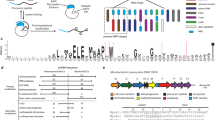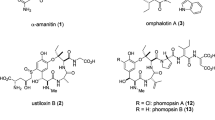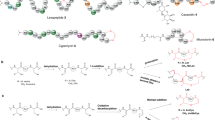Abstract
Ribosomally synthesized and post-translationally modified peptides (RiPPs) are a rapidly growing class of natural products. RiPP precursor peptides can undergo extensive enzymatic tailoring to yield structurally and functionally diverse products, and their biosynthetic logic makes them attractive bioengineering targets. Recent work suggests that unrelated RiPP-modifying enzymes contain structurally similar precursor peptide–binding domains. Using profile hidden Markov model comparisons, we discovered related and previously unrecognized peptide-binding domains in proteins spanning the majority of known prokaryotic RiPP classes, and we named this conserved domain the RiPP precursor peptide recognition element (RRE). Through binding studies we verified RRE's roles for three distinct RiPP classes: linear azole-containing peptides, thiopeptides and lasso peptides. Because numerous RiPP biosynthetic enzymes act on peptide substrates, our findings have powerful predictive value as to which protein(s) drive substrate binding, thereby laying a foundation for further characterization of RiPP biosynthetic pathways and the rational engineering of new peptide-binding activities.
This is a preview of subscription content, access via your institution
Access options
Subscribe to this journal
Receive 12 print issues and online access
$259.00 per year
only $21.58 per issue
Buy this article
- Purchase on Springer Link
- Instant access to full article PDF
Prices may be subject to local taxes which are calculated during checkout



Similar content being viewed by others
References
Newman, D.J. & Cragg, G.M. Natural products as sources of new drugs over the 30 years from 1981 to 2010. J. Nat. Prod. 75, 311–335 (2012).
Carlson, E.E. Natural products as chemical probes. ACS Chem. Biol. 5, 639–653 (2010).
Arnison, P.G. et al. Ribosomally synthesized and posttranslationally modified peptide natural products: overview and recommendations for a universal nomenclature. Nat. Prod. Rep. 30, 108–160 (2013).
Bindman, N.A. & van der Donk, W.A. A general method for fluorescent labeling of the N-termini of lanthipeptides and its application to visualize their cellular localization. J. Am. Chem. Soc. 135, 10362–10371 (2013).
Cotter, P.D., Ross, R.P. & Hill, C. Bacteriocins—a viable alternative to antibiotics? Nat. Rev. Microbiol. 11, 95–105 (2013).
Oman, T.J. & van der Donk, W.A. Follow the leader: the use of leader peptides to guide natural product biosynthesis. Nat. Chem. Biol. 6, 9–18 (2010).
Ruffner, D.E., Schmidt, E.W. & Heemstra, J.R. Assessing the combinatorial potential of the RiPP cyanobactin tru pathway. ACS Synth. Biol. 4, 482–492 (2015).
Goto, Y., Ito, Y., Kato, Y., Tsunoda, S. & Suga, H. One-pot synthesis of azoline-containing peptides in a cell-free translation system integrated with a posttranslational cyclodehydratase. Chem. Biol. 21, 766–774 (2014).
Deane, C.D., Melby, J.O., Molohon, K.J., Susarrey, A.R. & Mitchell, D.A. Engineering unnatural variants of plantazolicin through codon reprogramming. ACS Chem. Biol. 8, 1998–2008 (2013).
Mitchell, D.A. et al. Structural and functional dissection of the heterocyclic peptide cytotoxin. J. Biol. Chem. 284, 13004–13012 (2009).
Melby, J.O., Nard, N.J. & Mitchell, D.A. Thiazole/oxazole-modified microcins: complex natural products from ribosomal templates. Curr. Opin. Chem. Biol. 15, 369–378 (2011).
Dunbar, K.L. et al. Discovery of a new ATP-binding motif involved in peptidic azoline biosynthesis. Nat. Chem. Biol. 10, 823–829 (2014).
Lee, S.W. et al. Discovery of a widely distributed toxin biosynthetic gene cluster. Proc. Natl. Acad. Sci. USA 105, 5879–5884 (2008).
Schmidt, E.W. et al. Patellamide A and C biosynthesis by a microcin-like pathway in Prochloron didemni, the cyanobacterial symbiont of Lissoclinum patella. Proc. Natl. Acad. Sci. USA 102, 7315–7320 (2005).
Li, Y.M., Milne, J.C., Madison, L.L., Kolter, R. & Walsh, C.T. From peptide precursors to oxazole and thiazole-containing peptide antibiotics: microcin B17 synthase. Science 274, 1188–1193 (1996).
Dunbar, K.L., Melby, J.O. & Mitchell, D.A. YcaO domains use ATP to activate amide backbones during peptide cyclodehydrations. Nat. Chem. Biol. 8, 569–575 (2012).
McIntosh, J.A. & Schmidt, E.W. Marine molecular machines: heterocyclization in cyanobactin biosynthesis. ChemBioChem 11, 1413–1421 (2010).
Burroughs, A.M., Iyer, L.M. & Aravind, L. Natural history of the E1-like superfamily: implication for adenylation, sulfur transfer and ubiquitin conjugation. Proteins 75, 895–910 (2009).
Melby, J.O., Dunbar, K.L., Trinh, N.Q. & Mitchell, D.A. Selectivity, directionality and promiscuity in peptide processing from a Bacillus sp. Al Hakam cyclodehydratase. J. Am. Chem. Soc. 134, 5309–5316 (2012).
Regni, C.A. et al. How the MccB bacterial ancestor of ubiquitin E1 initiates biosynthesis of the microcin C7 antibiotic. EMBO J. 28, 1953–1964 (2009).
McIntosh, J.A., Lin, Z., Tianero, M.D. & Schmidt, E.W. Aestuaramides, a natural library of cyanobactin cyclic peptides resulting from isoprene-derived Claisen rearrangements. ACS Chem. Biol. 8, 877–883 (2013).
Ortega, M.A. et al. Structure and mechanism of the tRNA-dependent lantibiotic dehydratase NisB. Nature 517, 509–512 (2015).
Altschul, S.F., Gish, W., Miller, W., Myers, E.W. & Lipman, D.J. Basic local alignment search tool. J. Mol. Biol. 215, 403–410 (1990).
Marchler-Bauer, A. et al. CDD: conserved domains and protein three-dimensional structure. Nucleic Acids Res. 41, D348–D352 (2013).
Söding, J., Biegert, A. & Lupas, A.N. The HHpred interactive server for protein homology detection and structure prediction. Nucleic Acids Res. 33, W244–W248 (2005).
Söding, J. Protein homology detection by HMM-HMM comparison. Bioinformatics 21, 951–960 (2005).
Lopes, A., Amarir-Bouhram, J., Faure, G., Petit, M.A. & Guerois, R. Detection of novel recombinases in bacteriophage genomes unveils Rad52, Rad51 and Gp2.5 remote homologs. Nucleic Acids Res. 38, 3952–3962 (2010).
Klinman, J.P. & Bonnot, F. Intrigues and intricacies of the biosynthetic pathways for the enzymatic quinocofactors: PQQ, TTQ, CTQ, TPQ and LTQ. Chem. Rev. 114, 4343–4365 (2014).
Latham, J.A., Iavarone, A.T., Barr, I., Juthani, P.V. & Klinman, J.P. PqqD is a novel peptide chaperone that forms a ternary complex with the radical S-adenosylmethionine protein PqqE in the pyrroloquinoline quinone biosynthetic pathway. J. Biol. Chem. 290, 12908–12918 (2015).
Tsai, T.Y., Yang, C.Y., Shih, H.L., Wang, A.H. & Chou, S.H. Xanthomonas campestris PqqD in the pyrroloquinoline quinone biosynthesis operon adopts a novel saddle-like fold that possibly serves as a PQQ carrier. Proteins 76, 1042–1048 (2009).
Holm, L. & Rosenstrom, P. Dali server: conservation mapping in 3D. Nucleic Acids Res. 38, W545–W549 (2010).
Wecksler, S.R. et al. Interaction of PqqE and PqqD in the pyrroloquinoline quinone (PQQ) biosynthetic pathway links PqqD to the radical SAM superfamily. Chem. Commun. (Camb.) 46, 7031–7033 (2010).
Li, Y., Zirah, S. & Rebuffat, S. in Lasso Peptides 81–95 (Springer, New York, 2015).
Geer, L.Y., Domrachev, M., Lipman, D.J. & Bryant, S.H. CDART: protein homology by domain architecture. Genome Res. 12, 1619–1623 (2002).
Haft, D.H. A strain-variable bacteriocin in Bacillus anthracis and Bacillus cereus with repeated Cys-Xaa-Xaa motifs. Biol. Direct 4, 15 (2009).
Dunbar, K.L., Tietz, J.I., Cox, C.L., Burkhart, B.J. & Mitchell, D.A. Identification of an auxiliary leader peptide–binding protein required for azoline formation in ribosomal natural products. J. Am. Chem. Soc. (in the press) (2015).
Bantysh, O. et al. Enzymatic synthesis of bioinformatically predicted microcin C–like compounds encoded by diverse bacteria. MBio 5, e01059–14 (2014).
Hegemann, J.D., Zimmermann, M., Zhu, S., Klug, D. & Marahiel, M.A. Lasso peptides from proteobacteria: Genome mining employing heterologous expression and mass spectrometry. Biopolymers 100, 527–542 (2013).
Haft, D.H. Bioinformatic evidence for a widely distributed, ribosomally produced electron carrier precursor, its maturation proteins and its nicotinoprotein redox partners. BMC Genomics 12, 21 (2011).
Haft, D.H. & Basu, M.K. Biological systems discovery in silico: radical S-adenosylmethionine protein families and their target peptides for posttranslational modification. J. Bacteriol. 193, 2745–2755 (2011).
Schramma, K.R., Bushin, L.B. & Seyedsayamdost, M.R. Structure and biosynthesis of a macrocyclic peptide containing an unprecedented lysine-to-tryptophan crosslink. Nat. Chem. 7, 431–437 (2015).
Goldman, P.J. et al. X-ray structure of an AdoMet radical activase reveals an anaerobic solution for formylglycine posttranslational modification. Proc. Natl. Acad. Sci. USA 110, 8519–8524 (2013).
Morinaka, B.I. et al. Radical S-adenosyl methionine epimerases: regioselective introduction of diverse d-amino acid patterns into peptide natural products. Angew. Chem. Int. Edn Engl. 53, 8503–8507 (2014).
Breil, B.T., Ludden, P.W. & Triplett, E.W. DNA sequence and mutational analysis of genes involved in the production and resistance of the antibiotic peptide trifolitoxin. J. Bacteriol. 175, 3693–3702 (1993).
Breil, B., Borneman, J. & Triplett, E.W. A newly discovered gene, tfuA, involved in the production of the ribosomally synthesized peptide antibiotic trifolitoxin. J. Bacteriol. 178, 4150–4156 (1996).
Molohon, K.J. et al. Structure determination and interception of biosynthetic intermediates for the plantazolicin class of highly discriminating antibiotics. ACS Chem. Biol. 6, 1307–1313 (2011).
Morris, R.P. et al. Ribosomally synthesized thiopeptide antibiotics targeting elongation factor Tu. J. Am. Chem. Soc. 131, 5946–5955 (2009).
Metelev, M. et al. Structure, bioactivity and resistance mechanism of streptomonomicin, an unusual lasso peptide from an understudied halophilic actinomycete. Chem. Biol. 22, 241–250 (2015).
Lee, J. et al. Structural and functional insight into an unexpectedly selective N-methyltransferase involved in plantazolicin biosynthesis. Proc. Natl. Acad. Sci. USA 110, 12954–12959 (2013).
Fedorov, A.A., Fedorov, E., Gertler, F. & Almo, S.C. Structure of EVH1, a novel proline-rich ligand-binding module involved in cytoskeletal dynamics and neural function. Nat. Struct. Mol. Biol. 6, 661–665 (1999).
Sievers, F. et al. Fast, scalable generation of high-quality protein multiple sequence alignments using Clustal Omega. Mol. Syst. Biol. 7, 539 (2011).
Šali, A. & Blundell, T.L. Comparative protein modelling by satisfaction of spatial restraints. J. Mol. Biol. 234, 779–815 (1993).
Šali, A., Potterton, L., Yuan, F., van Vlijmen, H. & Karplus, M. Evaluation of comparative protein modeling by MODELLER. Proteins 23, 318–326 (1995).
Atkinson, H.J., Morris, J.H., Ferrin, T.E. & Babbitt, P.C. Using sequence similarity networks for visualization of relationships across diverse protein superfamilies. PLoS ONE 4, e4345 (2009).
Shannon, P. et al. Cytoscape: a software environment for integrated models of biomolecular interaction networks. Genome Res. 13, 2498–2504 (2003).
Zhao, S. et al. Prediction and characterization of enzymatic activities guided by sequence similarity and genome neighborhood networks. eLife 3, e03275 (2014).
Acknowledgements
We are grateful to A. Maniak and R. Dowen for cloning several of the TOMM biosynthetic proteins and to C. Cox for bioinformatics consultation. We also thank C. Deane for critical review of this manuscript. This work was supported by the US National Institutes of Health (NIH) (1R01 GM097142 to D.A.M. and 2T32 GM070421 to B.J.B. and K.L.D.). Additional financial support came from the University of Illinois at Urbana-Champaign Department of Chemistry (Robert C. and Carolyn J. Springborn Endowment to B.J.B. and Harold R. Snyder Fellowship to K.L.D. and G.A.H.). B.J.B. was also funded by a National Science Foundation Graduate Research Fellowship (DGE-1144245).
Author information
Authors and Affiliations
Contributions
Experiments were designed by D.A.M. and B.J.B. and performed by B.J.B. Critical reagents were provided by K.L.D. and G.A.H. The manuscript was written by D.A.M. and B.J.B. The overall study was conceived and managed by D.A.M.
Corresponding author
Ethics declarations
Competing interests
The authors declare no competing financial interests.
Supplementary information
Supplementary Text and Figures
Supplementary Results, Supplementary Tables 1–6 and Supplementary Figures 1–10. (PDF 20420 kb)
Rights and permissions
About this article
Cite this article
Burkhart, B., Hudson, G., Dunbar, K. et al. A prevalent peptide-binding domain guides ribosomal natural product biosynthesis. Nat Chem Biol 11, 564–570 (2015). https://doi.org/10.1038/nchembio.1856
Received:
Accepted:
Published:
Issue Date:
DOI: https://doi.org/10.1038/nchembio.1856
This article is cited by
-
Designer installation of a substrate recruitment domain to tailor enzyme specificity
Nature Chemical Biology (2023)
-
Structural and mechanistic basis for RiPP epimerization by a radical SAM enzyme
Nature Chemical Biology (2023)
-
Genome mining unveils a class of ribosomal peptides with two amino termini
Nature Communications (2023)
-
A biosynthetic pathway to aromatic amines that uses glycyl-tRNA as nitrogen donor
Nature Chemistry (2022)
-
Crystal structure and catalytic mechanism of the MbnBC holoenzyme required for methanobactin biosynthesis
Cell Research (2022)



